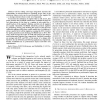Free Online Productivity Tools
i2Speak
i2Symbol
i2OCR
iTex2Img
iWeb2Print
iWeb2Shot
i2Type
iPdf2Split
iPdf2Merge
i2Bopomofo
i2Arabic
i2Style
i2Image
i2PDF
iLatex2Rtf
Sci2ools
DSN
2007
IEEE
2007
IEEE
Using Register Lifetime Predictions to Protect Register Files against Soft Errors
— Device scaling and large integration increase the vulnerability of microprocessors to transient errors. One of the structures where errors can be most harmful is the register file — a storage structure that is read very frequently. To increase the resistance of register files to soft errors, this paper presents the ParShield architecture. ParShield is based on two observations: (i) the data in a register is only useful for a small fraction of the register’s lifetime, and (ii) not all registers are equally vulnerable. ParShield selectively protects registers by generating, storing, and checking the ECCs of only the most vulnerable registers while they contain useful data. In addition, it stores a parity bit for all the registers, re-using the ECC circuitry for parity generation and checking. ParShield has no SDC AVF and a small average DUE AVF of 0.040 and 0.010 for the integer and floating-point register files, respectively. ParShield consumes on average only 81% and 78% of...
| Added | 02 Jun 2010 |
| Updated | 02 Jun 2010 |
| Type | Conference |
| Year | 2007 |
| Where | DSN |
| Authors | Pablo Montesinos, Wei Liu, Josep Torrellas |
Comments (0)

